
If you think students in Cambridge today rule the roost, you don't know you are born. In the late nineteenth and early twentieth centuries undergraduates had complete contempt for all forms of authority.
This was the age of the cult of manliness, sports clubs, and the Cambridge Union, and attitudes were perhaps personified in Kipling's poem "If". The British Empire was a fact of ordinary life, and Empire Day was widely celebrated by all sections of the community, and is still remembered by some older people today.
The first big bonfire was in the market square in 1897 and was part of a protest against women being awarded degrees rather than just tripos certificates. Newnham and Girton Colleges were exclusively female. Bicycles liberated them, but they were not full members of the University, and had to wait until 1948 to be awarded full degrees at Cambridge, long after other universities were awarding degrees to women.
There was another and bigger bonfire in the market square in 1898 to celebrate Kitchener's award of an honorary degree following his victory at the Battle of Omdurman. The students were completely out of control, but were supported by the public. Punching was considered acceptable but kicking fallen victims was not. Some students were charged with theft but the Home Secretary pardoned them all. So much material for the bonfire was taken from nearby buildings and gardens that they managed to melt a street light.
The Boer War provided further opportunities for bigger and better bonfires particularly on the relief of Ladysmith in March 1900. Bonfire material in the form of market stalls, advertising hoardings and hotel chairs was readily available and fully utilised.
When the relief of Mafeking in May 1900 was imminent, the deputy mayor, Horace Darwin (son of Charles Darwin) established a bonfire committee including all the sports captains to provide a controlled bonfire on Midsummer Common, together with a torch-light procession, and in the event all went peacefully.
Finally in 1902 when the peace was signed ending the Boer War, the students wanted to hold another bonfire night, but the town was now against it, which enabled the authorities to regain control, and the era of student mayhem was at an end.
Jim Butchart